Topics
Category
Era
Motorettes
Three of the first motorettes report for work at Nicollet Station, Thirty-first Street and Nicollet Avenue, Minneapolis, 1943.
Before World War II, operating streetcars was considered a man’s job. A 1916 Twin City Rapid Transit (TCRT) report shows sixty-eight female employees out of a workforce of 4,300, and those few were telephone operators and clerical office workers.
Twin Cities streetcar ridership grew from 105 million in 1940 to almost 194 million in 1945, owing to World War II gas and rubber rationing and to a surging wartime economy. At the same time, hundreds of public-transportation employees were entering military service. Like so many other industries and businesses during the war, TCRT turned to women to fill the jobs. The company placed ads in newspapers and began hiring women in July 1943. That year, forty-seven worked as car cleaners and seven as bus drivers, plus an unknown number in other jobs, including mechanics.
However, the majority of the female employees ran streetcars. The title motorman was inappropriate, so the term motorette was coined. Between July 1943 and November 1945, the TCRT hired 381 motorettes. Even though this was an era when many women did not drive, a driver’s license was not required to run a streetcar.
Streetcars had been modified in the 1930s so that a single person—the motorman or motorette—could operate them and also collect fares. On those streetcars that still required a two-person crew, the conductor collected fares at the rear platform. The war and retirement sufficiently reduced the conductor ranks so that from April 1944 to October 1945, 126 “conductorettes” were hired to assist the drivers.
Although generally well received by their coworkers, the public wasn't always so accepting of these female employees. When interviewed, several motorettes told of passengers refusing to ride with a woman and waiting for the next car. One conductorette was beaten by a drunken returning serviceman who accused her of taking a job from a man.
TCRT initially designed a women’s uniform, which consisted of a tailored jacket, vest, and trousers and a hat with braided band that was softer and smaller in diameter than a man’s hat. The initials TCL (for Twin City Lines) were intertwined to form a new logo that was displayed on the cap and coat lapels. Later photos show women wearing the same uniform as the men. They often provided their own trousers but never wore skirts.
Up to 183 women were employed by TCRT at any one time during the war years. Most worked less than one year and left soon after the war ended, in September 1945. By the end of 1946, only thirty-seven remained. Of those remaining, a few switched to bus driving. Ruby Peterson was the last one, working on the Selby-Lake route for many years before retiring in 1980.
Bibliography
Diers, John W. and Aaron Isaacs. Twin Cities by Trolley. Minneapolis: University of Minnesota Press, 2007.
Isaacs, Aaron. “Conductresses.” Twin City Lines (Fall 2011): 13–14.
———. “Keeping Buses and Streetcars Clean is Daily Job of 47 Twin Cities Women.” Twin City Lines (Spring 2012): 16.
———. “The Motorettes Reunion.” Minnegazette (Fall 1993): 14-21.
———. “The War Effort, VJ Day.” In Twin City Lines, The 1940s, 24, 25, 27 Minneapolis: Minnesota Transportation Museum,1995.
———. “World War I Motorettes.” Twin City Lines (Spring 2008): 17, 24.
Related Resources
Primary
Motorette and Conductorette Roster
Manuscript Collection, Minnesota Streetcar Museum, Minneapolis
Secondary
Olson, Russell. The Electric Railways of Minnesota. St. Paul: H. M. Smyth Company, 1976.
Related Images
This photo taken about 1918 is the only known picture of women who ran streetcars in Minneapolis during World War I. The numbers on the hats indicate that the one on the left is a conductor (even number) and that the one on the right is a motorette (odd number). The numbers imply that the women were based at the North Side Station, Twenty-fourth Avenue North and Washington Avenue, Minneapolis.
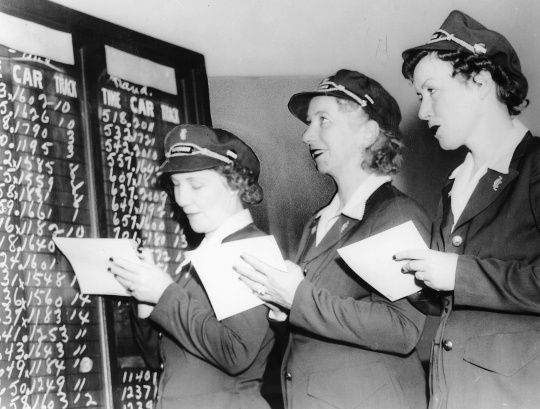
World War II motorettes
Three of the first motorettes report for work at Nicollet Station, Thirty-first Street and Nicollet Avenue, Minneapolis, 1943.
Holding Location
Articles
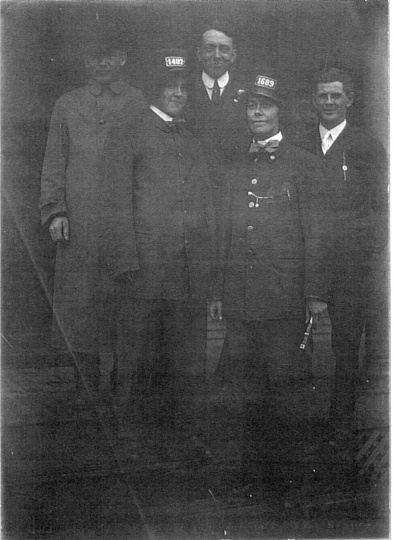
Female streetcar operators
This photo taken about 1918 is the only known picture of women who ran streetcars in Minneapolis during World War I. The numbers on the hats indicate that the one on the left is a conductor (even number) and that the one on the right is a motorette (odd number). The numbers imply that the women were based at the North Side Station, Twenty-fourth Avenue North and Washington Avenue, Minneapolis.
Public domain
Holding Location
Articles
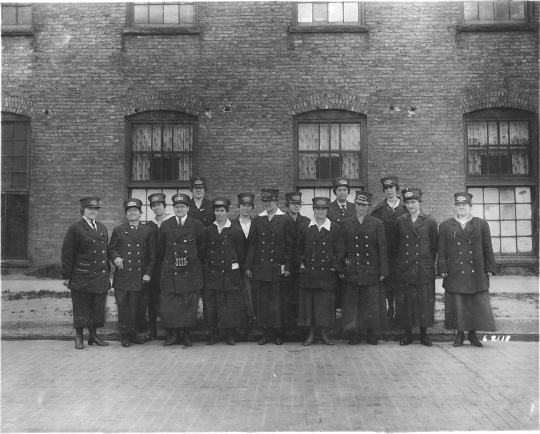
Duluth streetcar conductresses
The Duluth Street Railway hired twenty-one women as streetcar conductors (or "conductresses," as they termed them) in 1918. Some of them posed outside the streetcar barn at Twenty-sixth Avenue West and Superior Street for this photo taken June 21, 1918.
Holding Location
Articles
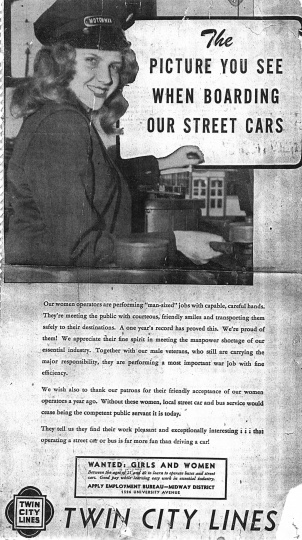
World War II motorette advertisement
A newspaper ad recruiting women to operate streetcars, 1944.
Holding Location
Articles
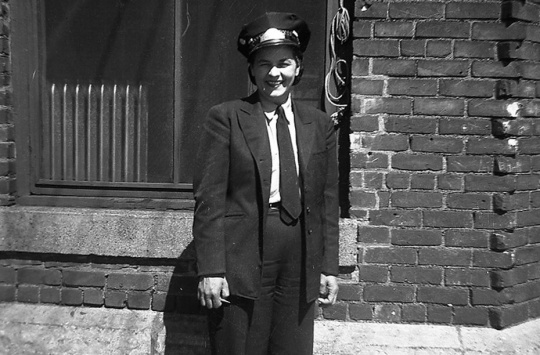
Motorette Helen Murphy
Motorette Helen Murphy at the Snelling Station, Snelling and University Avenues, St. Paul, about 1945.
Holding Location
Articles
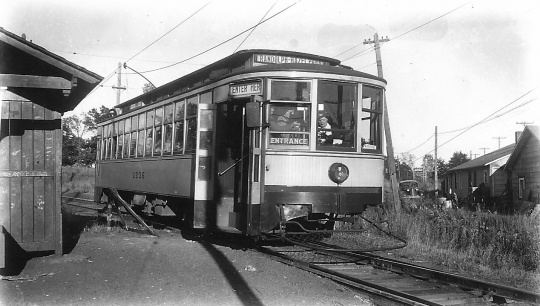
Motorette operating a streetcar, c. 1945
A streetcar operated by a motorette in Willernie, c.1945.
Holding Location
Articles
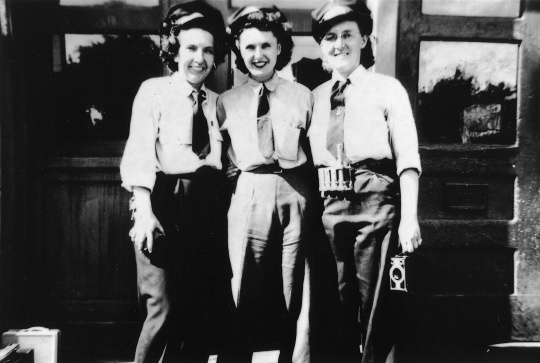
Motorettes Marie Hagen, Bernice Nelson, and Verna Fox
Motorettes Marie Hagen (left), Bernice Nelson, and Verna Fox at Lake Street Station, Twenty-first Avenue South and Lake Street, Minneapolis, 1945.
Holding Location
Articles
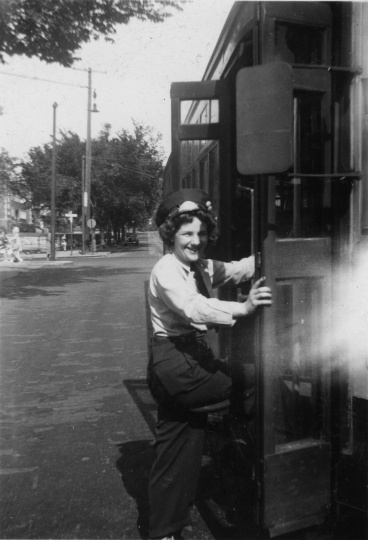
Motorette Helen Murphy
Motorette Helen Murphy, St. Paul, 1946.
All rights reserved
Holding Location
Articles
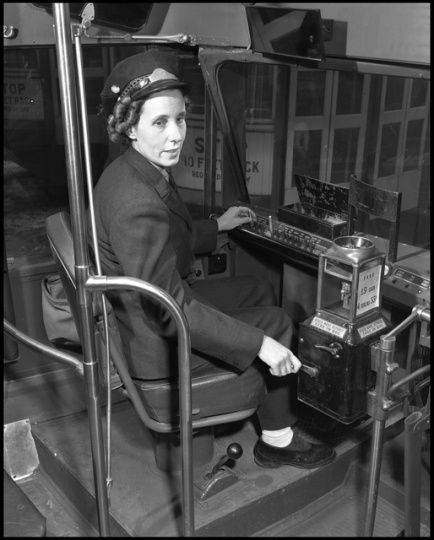
Elizabeth Pederson at the controls of a streetcar
Motorette Elizabeth Pederson at the controls of a streetcar at East Side Station, University Avenue and First Avenue NE, Minneapolis, December 4, 1950. Pederson retired in 1973.
Holding Location
Articles
Related Articles
Turning Point
Like a great many other industries and businesses during World War II, Twin City Rapid Transit turns to women to fill jobs.
Chronology
1919
1929
1943
1944
1945
1946
1980
1993
Bibliography
Diers, John W. and Aaron Isaacs. Twin Cities by Trolley. Minneapolis: University of Minnesota Press, 2007.
Isaacs, Aaron. “Conductresses.” Twin City Lines (Fall 2011): 13–14.
———. “Keeping Buses and Streetcars Clean is Daily Job of 47 Twin Cities Women.” Twin City Lines (Spring 2012): 16.
———. “The Motorettes Reunion.” Minnegazette (Fall 1993): 14-21.
———. “The War Effort, VJ Day.” In Twin City Lines, The 1940s, 24, 25, 27 Minneapolis: Minnesota Transportation Museum,1995.
———. “World War I Motorettes.” Twin City Lines (Spring 2008): 17, 24.
Related Resources
Primary
Motorette and Conductorette Roster
Manuscript Collection, Minnesota Streetcar Museum, Minneapolis
Secondary
Olson, Russell. The Electric Railways of Minnesota. St. Paul: H. M. Smyth Company, 1976.










